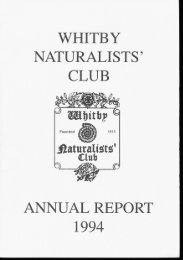2005 - Whitby Naturalists
2005 - Whitby Naturalists
2005 - Whitby Naturalists
Create successful ePaper yourself
Turn your PDF publications into a flip-book with our unique Google optimized e-Paper software.
magically calmed the weather and the waves-hence the term haicyon<br />
days. The zoologists of two hundred years ago who namcd the genus<br />
were steeped in classical lore, and thought the colonial masses of<br />
,\Icyonium rcsemhled the descriptions of the tangled nest of the fabled<br />
bird, and in fond conceit namcd the genus so. They did redeem<br />
themseives, however, in providing the apt digitatum as the trivial<br />
epitlret, so that thc speciesl name in f'rll is Alcyaniwn diEtatu"tn.<br />
Deacl Men's Fingers form cpntinuous mats with their colonial lobes<br />
projecring from rocks, or any hard substrates, including man-made<br />
structures such as piers or drllllng rigs. They can accclerate corrosicn<br />
on metal structures, and as fouling organisms they increase drag in<br />
moving vessels. The colonies are found from just bclow the lowest tide<br />
leve1s to depths clf 50 metres ot morc. The colonies arc usually pale<br />
veilow or white, and as th"ey waft and sway in the currents look for all<br />
the world like fore sts of cadaverous hands. Each colony consists of sea<br />
anemone-like polyps, called zooids, linked togcther in a gelatinous<br />
mass supported by a loose skclcton of lirnestone spicules. Each zooid<br />
has eight feathery tentacles, which collect detritus falling through the<br />
sea. Alcyonium is a soft coral allicd to the sea pens and sea fans. Unlike<br />
the tropical corals it does ltc)t folm reefs since it is unable to concfetc<br />
its spicuies together to form a massive, rocky skeleton.<br />
Alryonirnn colonics are an important part of the marine fauna as they<br />
form a large part of the biomass of suspension ' feeding cornnunitics'<br />
They play a role in trapping carbon, by cxtracting carbonic acid<br />
(dissolved carbon dioxidc) from the watcf and using it in reaction with<br />
calcium to build up their skeleton, In this way they contribute to<br />
reducing levels of frcc carbon dioxide, and reducc *re acidity of the se a<br />
water. They are sensitive to high temperatures, and die away if the<br />
water becomes too warm. This is, of course, a "double whammy" since<br />
their loss io the environment meatls that less carbon dioxide is trappcd<br />
and the greenhotrse effcct of the increased carbon dioxide leads to<br />
further global warming which in turn reduces the populations of the<br />
50




